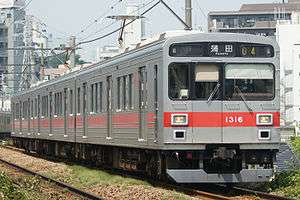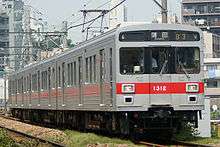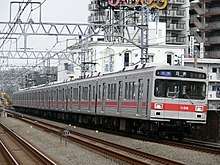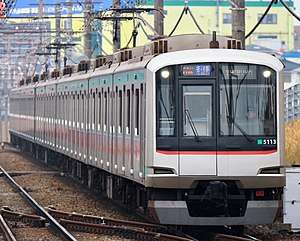Tokyu 1000 series
The Tokyu 1000 series (東急1000系, Tōkyū 1000-kei) is an electric multiple unit (EMU) train type operated by the private railway operator Tokyu Corporation on the Tokyu Ikegami and Tokyu Tamagawa lines in Japan since 1988.[1]
| Tokyu 1000 series | |
|---|---|
 3-car Ikegami Line set 1016 in July 2008 | |
| Constructed | 1988–1993 |
| Entered service | December 1988 |
| Refurbished | 2014– |
| Number built | 113 vehicles |
| Number in service | 27 vehicles (9 sets) |
| Formation | 3/8 cars per trainset |
| Operator(s) | Tokyu Corporation |
| Line(s) served | Tokyu Ikegami Line Tokyu Tamagawa Line |
| Specifications | |
| Car body construction | Stainless steel |
| Car length | 18,000 mm (59 ft 1 in) |
| Width | 2,800 mm (9 ft 2 in) |
| Doors | 3 pairs per side |
| Maximum speed | 120 km/h (75 mph) |
| Traction system | Variable frequency (GTO) (1000 series sets) Variable frequency (IGBT) (1000-1500 series sets) |
| Acceleration | 3.5 km/h/s |
| Deceleration | 3.5 km/h/2 (service) 4.5 km/h/s (emergency) |
| Electric system(s) | 1,500 V DC |
| Current collection method | Overhead wire |
| Track gauge | 1,067 mm (3 ft 6 in) |
Design
Based on the earlier Tokyu 9000 series design, the 1000 series trains were built for use on through-running services to and from the Tokyo Metro Hibiya Line subway.[1] Cars are 18 metres long and have three pairs of doors per side.[1]
Operations
Three-car sets have operated on the Tokyu Ikegami Line since 1993.[1] Four-car sets formerly operated on the Tokyu Mekama Line (present-day Tokyu Tamagawa Line and Tokyu Meguro Line), and eight-car formations formerly operated on the Tokyu Toyoko Line, with through-running to and from the Tokyo Metro Hibiya Line subway. The former were reformed as three-car sets, and the latter were taken out of use from 15 March 2013.[1] From May 2014, former eight-car Tokyu Toyoko Line sets were reformed into three-car sets and refurbished for use on the Tokyu Tamagawa Line and Tokyu Meguro Line, reclassified as 1000-1500 series.[2]
Formations
3-car sets

As of 1 April 2013, the fleet consists of nine three-car sets, formed as follows, with two motored ("M") cars and one non-powered trailer ("T") car, and car 1 at the Gotanda/Tamagawa end.[3]
| Car No. | 1 | 2 | 3 |
|---|---|---|---|
| Designation | Tc | M | Mc |
| Numbering | 1000 | 1200 | 1300 |
Sets 1012 and 1014 have end cars with a central gangway door instead of the offset emergency gangway door on other units.[3] These two sets were originally built as four-car sets designed to operate in pairs on Toyoko Line through services.[4] Cars 2 and 3 are each fitted with a single-arm pantograph.[3]
3-car 1000-1500 series sets
The three-car 1000-1500 series sets are formed as shown below, with two motored ("M") cars and one non-powered trailer ("T") car.[2]
| Designation | Mc | M | Tc |
|---|---|---|---|
| Numbering | 1500 | 1600 | 1700 |
| Weight (t) | 33.4 | 34.7 | 28.9 |
| Capacity (Total) | 125 | 135 | 125 |
- The 150x cars were converted from former 100x driving trailer cars, the 160x cars were converted from former 120x motor cars, and the 170x cars were converted from former 110x driving trailer cars.[2]
- The 160x cars are fitted with two single-arm pantographs.[2]
- The motor cars are mounted on TS-1006 bogies, and the trailer cars are mounted on TS-1007 bogies.[2]
8-car sets

The eight-car sets used on the Toyoko Line up until March 2013 were formed as follows, with car 1 at the northern end.[3]
| Car No. | 1 | 2 | 3 | 4 | 5 | 6 | 7 | 8 |
|---|---|---|---|---|---|---|---|---|
| Designation | Tc2 | M2 | M1 | M2 | M1 | M2 | M1 | Tc1 |
| Numbering | 1000 | 1250 | 1200 | 1350 | 1300 | 1450 | 1400 | 1100 |
Cars 3, 5, and 7 were each fitted with a lozenge-type pantograph.[3] Cars 2 and 7 included wheelchair spaces.[3]
Interior
Passenger accommodation consists of longitudinal seating throughout, with a mixture of brown and orange seat moquette.[1] The 1000-1500 series sets formed from 2014 have light green seat moquette and a wheelchair space added in the 160x cars.[2]
History
Initially introduced on the Tokyu Toyoko Line from 26 December 1988,[5] they were also introduced on the Mekama Line from 1991. These were transferred to the Ikegami Line from 1992, and further new trains were built for the Ikegami Line in 1993.[1] The last set delivered, 1024, was the first Tokyu EMU to be built with a wheelchair space.[1] The Ikegami Line fleet underwent modifications in 1998 for use on wanman driver only operation services.[1]
Livery variations
From March 2016, three-car set 1017 received a dark blue and yellow retro-style livery based on the livery applied to the 3450 series trains that operated on the Ikegami Line until 1989.[6]
 Set 1017 in September 2016
Set 1017 in September 2016- A 3450 series train in blue and yellow livery in August 1983
Withdrawal and resale
Withdrawals started in 2008, with some cars being resold to the Ueda Electric Railway and the Iga Railway.[1] Further cars were resold to the Ichibata Electric Railway in 2014,[4] and to Fukushima Transportation in 2017.[7]
- Ueda Electric Railway 1000 series and 6000 series
- Iga Railway 200 series
- Ichibata Electric Railway 1000 series two-car sets (since February 2015)
- Fukushima Transportation 1000 series two- and three-car sets (since 2017)
Ueda Electric Railway
Eight former Tokyu Ikegami Line 1000 series end cars were resold to the Ueda Electric Railway in Nagano Prefecture, and reformed as four two-car 1000 series sets.[8]
In 2015, two former Tokyu Toyoko Line 1000 series intermediate cars (DeHa 1255 and DeHa 1305) were resold to the Ueda Electric Railway, which were reformed as a two-car 6000 series set with the addition of new cab ends.[4]
1000 series formations
| Designation | Mc | Tc |
|---|---|---|
| Numbering | DeHa 100x | KuHa 110x |
6000 series formation
| Designation | Mc | Tc |
|---|---|---|
| Numbering | DeHa 6001x | KuHa 6101x |
Car identities
The former identities of the fleet are as shown below.[8]
| Set No. | Car No. | Tokyu numbering |
|---|---|---|
| 1001 | DeHa 1001 | DeHa 1315 |
| KuHa 1101 | KuHa 1015 | |
| 1002 | DeHa 1002 | DeHa 1318 |
| KuHa 1102 | KuHa 1018 | |
| 1003 | DeHa 1003 | DeHa 1314 |
| KuHa 1103 | KuHa 1014 | |
| 1004 | DeHa 1004 | DeHa 1316 |
| KuHa 1104 | KuHa 1016 | |
| 6001 | DeHa 6001 | DeHa 1305 |
| KuHa 6101 | DeHa 1255 |
 Ueda 1000 series set 1001 in May 2012
Ueda 1000 series set 1001 in May 2012 Ueda 6000 series set 6001 in January 2017
Ueda 6000 series set 6001 in January 2017
Iga Railway
The Iga Railway in Mie Prefecture operates five two-car 200 series EMUs formed from ten former Tokyu 1000 series cars (from former sets 1010, 1011, and 1006) purchased between 2009 and 2012.[8]
The two end cars from the former eight-car set reformed from two four-car sets 1010 and 1011 were resold to the Iga Railway in 2009 after the set was withdrawn. The six intermediate cars of the set were scrapped.[4] The two intermediate driving cars (with central gangway doors) originally formed in sets 1010 and 1011 before they were combined to become a single eight-car set were also sold to Iga Railway in 2010.[4] Following its withdrawal in June 2009, eight-car set 1006 donated six cars, which were resold to Iga Railway between 2010 and 2012. The other two cars of the set were scrapped.[4]
Formations
| Designation | Mc | Tc |
|---|---|---|
| Numbering | Mo 20x | Ku 10x |
Car identities
The former identities of the fleet are as shown below.[8]
| Set No. | Car No. | Tokyu numbering |
|---|---|---|
| 201 | Mo 201 | DeHa 1311 |
| Ku 101 | KuHa 1010 | |
| 202 | Mo 202 | DeHa 1310 |
| Ku 102 | KuHa 1011 | |
| 203 | Mo 203 | DeHa 1406 |
| Ku 103 | KuHa 1106 | |
| 204 | Mo 204 | DeHa 1206 |
| Ku 104 | KuHa 1006 | |
| 205 | Mo 205 | DeHa 1306 |
| Ku 105 | DeHa 1356 |
- Iga Railway 200 series 2-car set 201 in December 2009, with original Tokyu cab and offset gangway door
- Iga Railway 200 series 2-car set 202 in December 2010, with original Tokyu cab and central gangway door
- Iga Railway 200 series 2-car set 204 in December 2010, with retro-fitted cab end
Ichibata Electric Railway
In 2014, four former 1000 series intermediate cars (1453, 1403, 1455, and 1405) were resold to the Ichibata Electric Railway in Shimane Prefecture, which were reformed as two-car 1000 series sets with the addition of new cab ends.[4] These entered service on 9 February 2015.[9]
Formations
| Designation | Mc | Tc |
|---|---|---|
| Numbering | DeHa 100x | KuHa 110x |
Car identities
The former identities of the fleet are as shown below.[8]
| Set No. | Car No. | Tokyu numbering |
|---|---|---|
| 1001 | DeHa 1001 | DeHa 1405 |
| KuHa 1101 | DeHa 1455 | |
| 1002 | DeHa 1002 | DeHa 1403 |
| KuHa 1102 | DeHa 1453 |
 Ichibata 1000 series set 1001 in September 2015
Ichibata 1000 series set 1001 in September 2015 Ichibata 1000 series set 1002 in September 2015
Ichibata 1000 series set 1002 in September 2015
Fukushima Transportation

In 2017, a number of former 1000 series cars were resold to Fukushima Transportation in Fukushima Prefecture for use on the Fukushima Kōtsū Iizaka Line.[7] Classified as 1000 series, the trains are formed as two- and three-car sets as follows.[7] Two sets (one two-car and one three-car set) were converted in fiscal 2016, entering service on 1 April 2017. Two more sets (one two-car and one three-car set) are scheduled to be introduced during fiscal 2017, followed by two more two-car sets in fiscal 2018, ultimately replacing the entire fleet of 7000 trainsets.[7]
Two-car sets
| Designation | Mc | Tc |
|---|---|---|
| Numbering | DeHa 11xx | KuHa 12xx |
Three-car sets
| Designation | Mc | M | Tc |
|---|---|---|---|
| Numbering | DeHa 11xx | DeHa 13xx | KuHa 12xx |
Car identities
The former identities of the fleet are as shown below.[7]
| Set No. | Car No. | Tokyu numbering |
|---|---|---|
| 1107 | DeHa 1107 | DeHa 1307 |
| KuHa 1208 | DeHa 1257 | |
| 1109 | DeHa 1109 | DeHa 1308 |
| DeHa 1313 | DeHa 1408 | |
| KuHa 1210 | DeHa 1258 |
References
| Wikimedia Commons has media related to Tokyu 1000 series. |
- 私鉄車両年鑑 2013: 大手15社営業用車両完全網羅 私鉄車両年鑑2013 [Japan Private Railways Annual 2013]. Tokyo, Japan: Ikaros Publications Ltd. 20 March 2013. p. 171. ISBN 978-4-86320-693-9.
- 東京急行電鉄1000系1500番台 [Tokyu 1000-1500 series]. Japan Railfan Magazine (in Japanese). Vol. 54 no. 639. Japan: Koyusha Co., Ltd. July 2014. pp. 90–91.
- 私鉄車両編成表 2014 [Private Railway Rolling Stock Formations - 2014] (in Japanese). Japan: Kotsu Shimbunsha. 24 July 2014. pp. 60–61. ISBN 978-4-330-48414-3.
- Kakino, Yoshinori (September 2015). 東京急行電鉄1000系の動き [Tokyu 1000 series changes]. Japan Railfan Magazine (in Japanese). Vol. 55 no. 653. Japan: Koyusha Co., Ltd. pp. 0–73.
- Terada, Hirokazu (October 2015). 他社へ転じた大手私鉄の車両たち 平成26年度分、34両を解析 [Major private railway rolling stock transferred to other operators - Fiscal 2014, 34 vehicles]. Japan Railfan Magazine (in Japanese). Vol. 55 no. 654. Japan: Koyusha Co., Ltd. pp. 95–96.
- 【東急】1000系 リバイバルカラー編成が営業運転開始 [Tokyu 1000 series enters service in revival livery]. RM News (in Japanese). Japan: Neko Publishing Co., Ltd. 5 April 2016. Retrieved 5 April 2016.
- 福島交通1000系 [Fukushima Transportation 1000 series]. Japan Railfan Magazine (in Japanese). Vol. 57 no. 674. Japan: Koyusha Co., Ltd. June 2017. pp. 96–97.
- Kubo, Toshi (July 2017). 東京メトロ日比谷線-4 [Tokyo Metro Hibiya Line - 4]. Japan Railfan Magazine (in Japanese). Vol. 57 no. 675. Japan: Koyusha Co., Ltd. pp. 125–126.
- 一畑電車で1000系の出発式 [Departure ceremony for Ichibata 1000 series]. Japan Railfan Magazine Online (in Japanese). Japan: Koyusha Co., Ltd. 9 February 2015. Retrieved 10 February 2015.
